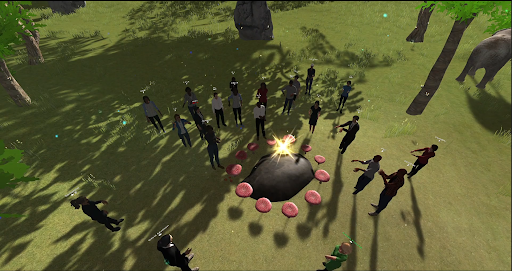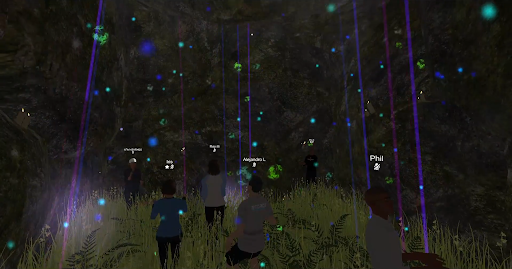Guest post: How Virtual Reality forges deep connection
Ways that VR can be a social emotional learning “connection engine” inside-out and outside-in, for building meaningful empathy-rich learning-and-being experiences
Caitlin Krause is a partner and guest blogger. She focuses on the intersection of technology, innovation, and well-being, and founded the studio and consultancy MindWise in 2015. She teaches about the subject at Stanford University, is a Senior Strategist at the Virtual World Society, and is the author of Mindful by Design (2019) and Designing Wonder (2020).
In August 2021, educators, learning designers, funders, and researchers took part in an active learning summit that broke many boundaries. The summit was hosted by education nonprofit the National Center for Families Learning (NCFL) in partnership with immersive technology organization Exponential Destiny and Broward County Public Schools, with funding provided by Verizon. Together these partners have been piloting immersive technologies as tools to enhance learning for low-income families.
During this event, summit participants had the opportunity to explore first hand several immersive environments to gain a better appreciation for how XR (Virtual Reality, Augmented Reality, and Mixed Reality) development can transform the quality of learning experiences. Wearing Virtual Reality (VR) headsets, they interacted with each other, investigated materials, and moved around to gain more context for understanding 3D spaces that offered depth, agency, and a sense of wonder.

As a longtime educator, programmer, and designer who is passionate about the intersections between technology, social emotional learning (SEL), and well-being, I created and guided a special part of the summit focused on an immersive SEL experience. My priority was to offer “2 P’s and 2 C’s” to participants: a sense of peace and place, and also connection and curiosity.
In a digital SEL environment, “peace” promotes calmness and tranquility, which is a great baseline for focus. A sense of “place” also lets a person relax in a virtual environment, because they already feel centered. These two elements are helpful bases for learning, because the amygdala of the brain isn’t firing, triggering the body to go into protection mode, which is easily possible when using powerful experience-driven VR technology.
The two C’s were also important for the SEL summit experience, offering participants a sense of community and collective agency and exploration. The “connection” exercises that I introduced in VR offered a chance for people to gain a sense of presence. As they enhanced an internal connection, recognizing the “now” moment, they were also able to appreciate others in the space, forming new relationships and friendships. Partner and group problem-solving was involved, too, as some of what we did involved journeys and opportunities to “find out more,” exercising curiosity.

The mind of a curious learner is certainly turned “on,” and we can each be transported through imagination and wonder. If we can give learners chances to connect internally and also with each other, we give our immersive spaces meaning and special emotional resonance, prioritizing positive social interactions with peers and mentors.
This “now moment” in history is a poignant one for our nation’s education landscape, when meaningful SEL-driven learning experiences can have a tremendous impact on learning outcomes and overall well-being. For learners, stress and anxiety is on the rise, and there is an enduring need for positive social connections. What guided my priorities as a VR experience designer is the opportunity to transform the digital learning space into a place of curiosity, connection, and delight.
Teaching middle school and high school humanities, English, and history for over a decade, I witnessed my students “light up” on a daily basis when my learning methodologies were framed in social structures that hinged on connection and care. Adolescents have brains that are developing socially, influenced by interactions with adults and peers around them. I found that immersive environments, which incorporate interactive exercises and game structures, can encourage participants to develop their “systems thinking,” understanding interconnectedness and non-linear structures. Digital learning also encouraged them to make a learning transfer back to related knowledge and understanding that is authentic to them, giving them a sense of agency and authority.
The methods of connection and care that I’ve used in my experience design approaches, for learners of all ages, can be transferred to initiatives that incorporate parents and caregivers in the learning process. For learners living in poverty and who are more likely to experience social isolation and anxiety, these methods may be even more important.
What I appreciate and intentionally build into VR creative experiences is what Seymour Papert called the “4 P’s”: projects, passion, peers, and play. Mitch Resnick now uses those 4 P’s to guide the Lifelong Kindergarten Lab at MIT’s Media Lab. When people are playing and interacting socially in groups, they lose themselves. They think openly. They engage and find joy in the learning process, while also feeling a sense of motivation. This is at the heart of well-designed SEL in VR. Of course, there’s extrinsic and intrinsic motivation to consider, and I would say the two are not exclusive. Learners can feel positively influenced in an immersive experience that involves pursuit of a “prize” as well as the internal rush of feeling that the experience itself, and the wonder and delight it inspires, is the boon. They exerted effort, and the rigor itself is part of the reward. When the SEL experience, with games and challenges built-in, is approached in a cooperative way, the meaning and sense of camaraderie, social learning, and healthy risk and reward can grow for learners of all ages.
To learn more about how immersive education can impact experiences for learners and teachers, watch the summit recording. Tune in during the 2021 Families Learning Conference on Tuesday, Oct. 26 at 1:45 p.m. CDT to hear from Caitlin and members of the VR team from Exponential Destiny, Broward County Public Schools, and NCFL.
ABOUT THE AUTHOR
Caitlin Krause focuses on the intersection of technology, innovation and well-being, and founded the studio and consultancy MindWise in 2015. She teaches about the subject at Stanford University, is a Senior Strategist at the Virtual World Society, and is a creative producer for ScienceVR. In September of 2020 she released the book Designing Wonder: Leading Transformative Experiences in VR. Caitlin has created and run numerous collaborative experiences in social XR, fusing presence, storytelling and emotional intelligence. After two decades of teaching, she authored Mindful By Design (Corwin Press, 2019) helping individuals and teams navigate complexity and change, prioritizing mindful well-being, design and imagination.
Further Reading References:
Farber, M., Williams, M. K., Mellman, L., & Yu, X. (2020). Systems at Play: Game Design as an Approach for Teen Self-Expression. Journal of Games, Self & Society. Carnegie Mellon University: ETC Press. 2(1), 40-84.
Horowitz, J. M., & Graf, N. (2019, February). Most U.S. teens see anxiety and depression as a major problem among their peers. Pew Research Center. Retrieved from https://www.pewresearch.org/social-trends/2019/02/20/most-u-s-teens-see-anxiety-and-depression-as-a-major-problem-among-their-peers/
Resnick, M. (2017). Lifelong kindergarten: Cultivating creativity through projects, passion, peers, and play. Cambridge, MA: MIT Press.
Papert, S. (1980). Mindstorms: Children, computers, and powerful ideas. New York, NY: Basic Books.